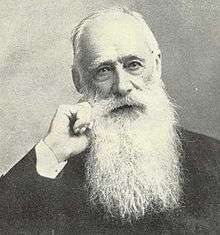Leonard Williams (bishop)
| William Leonard Williams | |
|---|---|
 Bishop William Leonard Williams | |
| Born |
22 July 1829 Paihia, New Zealand |
| Died |
1916 Napier, New Zealand |
| Nationality | New Zealand |
| Occupation | Anglican Bishop |
| Known for | Study of the Māori language and contributing to the study of New Zealand plants |
| Spouse(s) | Sarah Wanklyn |
William Leonard Williams (1829–1916) was an Anglican Bishop of Waiapu. He was regarded as an eminent scholar of the Māori language.[1]
Early life

Williams was born on the 22 July 1829 at Paihia, Bay of Islands, New Zealand. He was the third child and first son of William Williams of the Church Mission Society and his wife, Jane.[2][3]
His father was the first Bishop of Waiapu, Leonard Williams was the third bishop,[1][4][5] and his son, Herbert Williams, was the 6th bishop of Waiapu.
He was educated in New Zealand before attending Magdelen Hall (now Hertford College, Oxford) from 1847 where he obtained a third class honours degree in June 1852. He became a member of the Church Missionary Society and undertook theological training at the Church Missionary Society College, Islington. He was admitted to Deacon's Orders by the Bishop of London on 22 March 1853.[6][7]
Leonard met the daughters of Mr. J. B. Wanklyn of Halecat, Witherslack, Cumbria when visiting his aunt, Catherine Heathcote, at Southwell, Nottinghamshire. They had been pupils at Catherine Heathcote's School. In the following year he married Sarah Wanklyn at St Paul's Church, Witherslack on 6 June 1853,[7] and both set sail in August on a five-month journey to New Zealand.
Career
Leonard Williams was the principal of the training school for Māori clergymen that Bishop Williams established at Waerenga-a-hika in Poverty Bay in September 1855. In 1862 Leonard was appointed to be Archdeacon of Waiapu.[6][8]
The First Taranaki War, from March 1860 until 1862 resulted in the East Cape and Poverty Bay area became increasingly unsettled. A ‘repudiationist’ movement developed in Poverty Bay. The Ngāti Kaipoho chief Raharuhi told Governor Thomas Gore Browne that the Māori did not recognise Queen Victoria’s claim to rule over them and that the lands which the settlers in Poverty Bay had obtained should be returned.[9]
The Pai Mārire (Hauhau) moved into Poverty Bay in March 1865. The Poverty Bay Māori were neither for nor against the Hauhau. While the Rongowhakaata iwi defended the mission, Bishop Williams lost confidence in the security of the mission when some chiefs provided support for the Hauhau and went to the Bay of Islands with is wife and daughters. However Leonard remained at the mission.[10]
The mission at Waerenga-a-hika became a battle ground and the buildings were destroyed. After the Hauhau were defeated the Māori in the Poverty Bay had a much reduced support for the Christian faith, although it was sustained where there were CMS missionaries and Māori clergymen.[11] Many Māori of the Urewera and Poverty Bay regions had adopted the Ringatu religion, which was framed in language taken from the Old Testament. Leonard Williams, travelled through the Ngāi Tūhoe country in 1878. He commented on the Ringatu religion: “Their manner was reverent and the petitions contained in their prayers were framed in language taken from the Old Testament, but the obvious objection to the whole system was that it was anti-Christian, being a deliberate rejection of all that the love of God has provided for sinners in Jesus Christ.”[12]
He was regarded as the most learned scholar of Māori culture. During his lifetime he reissued his father's publication, A dictionary of the New Zealand language twice, as well as publishing his own book introducing the Māori language and contributing to the study of New Zealand plants.[2] The dictionary was again reissued by his son, the Rt Revd Herbert Williams, who also followed Williams and his father as a bishop of the same diocese.
Williams became the third Bishop of Waiapu in 1895.[13] He would travel on horseback around his diocese accompanied by two assistants. Williams retired in 1909 when he found the job too difficult. He died at his home in Napier in 1916.[2]
References
| Wikimedia Commons has media related to Leonard Williams (bishop). |
- 1 2 NZETC
- 1 2 3 Porter, Frances. "Williams, William Leonard". Dictionary of New Zealand Biography. Ministry for Culture and Heritage. Retrieved 4 April 2011.
- ↑ "Rev. William Williams family". Pre 1839 foreigners in NZ. Retrieved 22 September 2013.
- ↑ Porter, Frances (30 October 2012). "Williams, William Leonard". Dictionary of New Zealand Biography. Te Ara – the Encyclopedia of New Zealand. Retrieved 22 September 2013.
- ↑ “Who was Who” 1897-1990 London, A & C Black, 1991 ISBN 0-7136-3457-X
- 1 2 "Blain Biographical Directory of Anglican clergy in the South Pacific" (PDF). 2015. Retrieved 12 December 2015.
- 1 2 Harvey-Williams, Nevil (March 2011). "The Williams Family in the 18th and 19th Centuries - Part 3". Retrieved 21 December 2013.
- ↑ Williams, William (1974). The Turanga journals, 1840–1850. F. Porter (Ed) Wellington,. p. 588.
- ↑ Williams, William (1974). The Turanga journals, 1840–1850. F. Porter (Ed). p. 593.
- ↑ Williams, William (1974). The Turanga journals, 1840–1850. F. Porter (Ed). p. 595.
- ↑ Williams, William (1974). The Turanga journals, 1840–1850. F. Porter (Ed). p. 600.
- ↑ Williams, William (1974). The Turanga journals, 1840–1850. F. Porter (Ed) Wellington,. p. 612.
- ↑ 'Williams, William', from An Encyclopaedia of New Zealand, edited by A. H. McLintock, originally published in 1966. Te Ara - The Encyclopedia of New Zealand, updated 18-Sep-2007, accessed 9 January 2007
| Religious titles | ||
|---|---|---|
| Preceded by Edward Stuart |
Bishop of Waiapu 1895–1909 |
Succeeded by Alfred Averill |